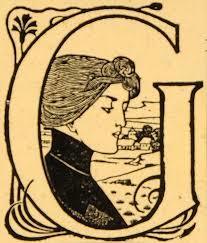 ROWING UP I used to enjoy reading Chicago Sun-Times columnist Sidney Harris--
ROWING UP I used to enjoy reading Chicago Sun-Times columnist Sidney Harris--

From time to time he would put out an article of strange bullet-pointed factoids entitled, if my recollection is correct, "Things I Learned While Looking Up Other Things." I remember one: The language of the Eskimo people is called Inuit. This snippet has stuck in my head for half a century. I have no idea why.
Anyway, today I am going to do something similar here. There are some facts about Minerva's Temple on the Aventine and the cult statue housed therein that I find interesting but haven't found a place for in any of this month's columns. I will present them now. After that I am going to do something else, a surprise (unless you're one of those annoying people who read the sub-title of the article first before you read the article, in which case it won't be much of a surprise. Just kidding).
A couple of different modern sources inform me that the Aventine Minerva came from Greece to Rome on a ship. Neither source provided citations. One of the sources was an auction house, and the gentleman who runs it directed me to a certain classical encyclopedia in my library, but I couldn't find any mention of it there. It's an interesting fact though since it means that this archaic statue (you can tell she's archaic even from her representation on the coins because she always seems to be balanced on her tiptoes) started out life as Athena. If she were Italian-born she would always have been called Minerva.
The Temple of Diana was right next to the Temple of Minerva on the Aventine Hill. They didn't share an orientation, which means they were set somehow kattywompus to each other. No city-planning involved there apparently. The poet Martial referred to the Aventine as "collem dominae Dianae," the hill of mistress Diana, in the 18th epigram of Book XII. This identification wouldn't have curried any imperial favor during the reign of Domitian, but it likely wasn't written until 101, so it no longer mattered.
Domitian wasn't the first emperor to have portrayed the Aventine cult statue on a coin. Here is a bronze coin in my possession from some thirty years earlier, from the reign of Claudius--
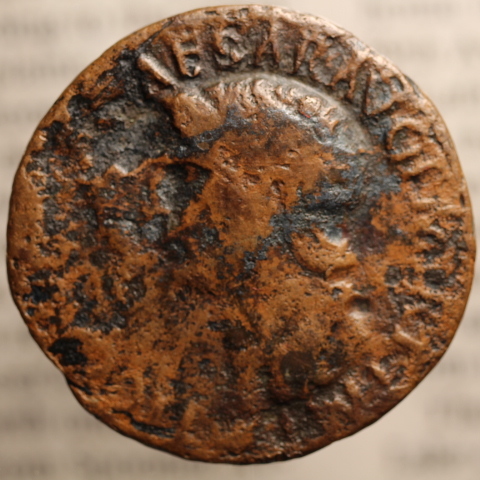
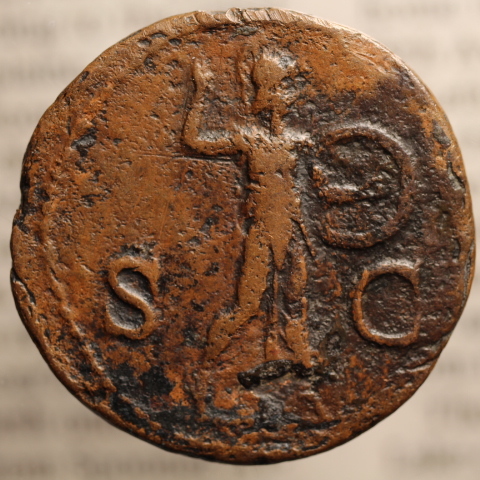
Minerva's Aventine temple was a hangout for poets. This isn't too surprising since the goddess was a patron of the arts. We can imagine Domitian there before the lightning struck and he was whisked away to the imperial palace (so to speak. He hated the palace, spent hardly any time there at all, and eventually built his own). I don't think Domitian ever considered it possible that he would be emperor one day. I believe he was resigned to, in fact, content to playing the part of imperial uncle to Titus's eventual heirs, all the while plugging away at his epic of the Jewish War. Anyway, the younger Domitian probably spent a lot of his free time at the Temple of Minerva on the Aventine. I'm sure he knew her cult statue very well.
* * *
Thursday night it was my turn to present to the Twin Cities Ancient Coin Club. My topic was the Commemorative Issue of 81, which I have discussed at some length on this website.
I began my speech talking about Julius Caesar and the Ides of March, evidently a mistake since everybody in the room probably knew more about Julius Caesar than I do. Tom, vice-president of the club and presiding officer that evening, called me to task on a particularly shaky point concerning the Theater of Pompey, which I had been hoping to finesse. Things fell apart a little bit at that point. In truth I was so rattled I needed to sit down for a minute to collect myself.
Turns out this whole introduction was a complete waste of effort. When I was able to resume my prepared remarks I'm afraid I left quite a lot out, including the connection between the Ides of March and the emperor Domitian. Oh well. After that somewhat dicey episode things went okay and I received two nice ovations, one of which I led myself.
After the presentation was over Mike, a club member, stood up and accused me of plagiarizing my entire speech, announcing he had already read all of it on the internet. This was a hilarious moment because Mike reads this blog, which was the point of his joke. However, funny as his comment was, Mike wasn't entirely correct. I introduced some information Thursday night that was totally new.
On the previous Tuesday, while preparing my slideshow with Google Slides, I had made a startling discovery. Actually more of an epiphany than a discovery, an actual Eureka Moment for me. "Εὔρηκα!" I said out loud. No kidding, I really did.
It seems that a brand new identification for the reverse of RIC 3 dropped as if dew from heaven, fully-formed and directly into my head! Regular readers might recognize RIC 3 from the blog article dated October 7, 2018, entitled "The Commemorative Issue of 81: Part 3, Domitian denarius, RIC 3 var, augurum vs auguralis." Here are the reverses of RIC 3 and RIC 3 var from the Hazelton coll.--
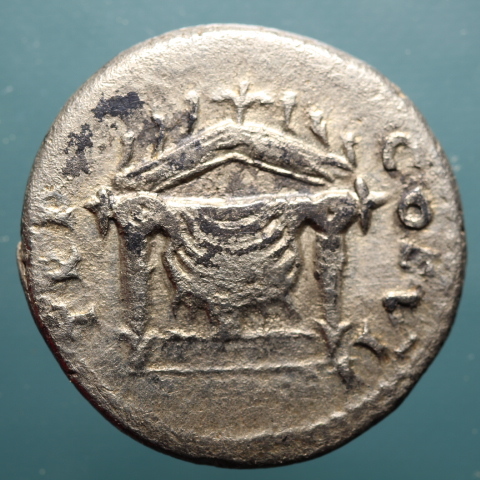
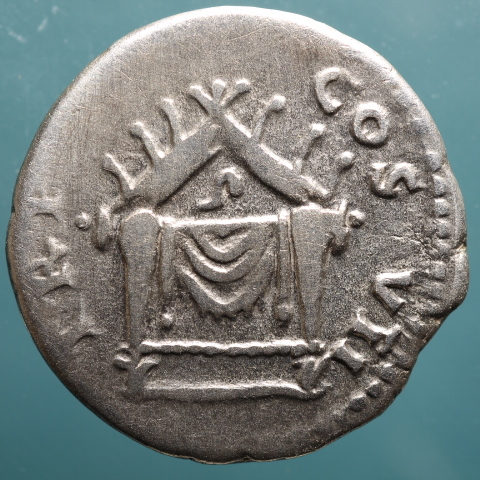
What they both depict is something called a pulvinarium, a sacred dining couch or throne carried processionally as a parade float. On the left we see a draped throne, surmounted by a rude structure formed by two sections of raw timber, joined together in the middle and forming a triangular arch. Topping the timber is a row of grain ears which I am now identifying as spelt, a type of wheat. (Spelt is my own backwards identification of this grain, engineered after I realized who the pulvinar belongs to, so bear with me here.)
On the right is the same pulvinar, more crudely-rendered perhaps, but showing the joined timbers more obviously. The spelt seems to be missing on this reverse, replaced by what appear to be truncated branches still adhering to the tree trunks. However it is still clearly a draped throne surmounted by a rude structure. What has been added is the strange device atop the throne and under the the raw timber. This is a lituus, a wand used in augury.
So, a godly throne, a rude structure, spelt, and, thrown in for good measure, the augurer’s lituus.
Years ago there was a TV show, Ellery Queen. Jim Hutton played the title role--

At the end of the third act in every show, Hutton would look right at the camera and announce that he had solved the case. He would tell us that we already had all the information that we would require in order to solve it also. Then he would cut to a commercial.
Once again, a godly throne, a rude structure, spelt, and a lituus. You now have all the information necessary to solve this mystery identification yourself! This is not a commercial website; I do it all for love. Therefore, in lieu of the commercial, let me cut to a story about two brothers--
The date, 753 B.C. The place, seven fertile hills near the Tyrrhenian coast of Italy. Twins Romulus and Remus each wanted to found a city. They couldn't just do it both together apparently, so they chose to decide the question with a contest of augury.
Romulus won and claimed the throne as Rome's first king.
The Romans preserved his house, a rude structure on the Palatine Hill, where it remained more or less intact at least until the Fourth Century A.D. The site has been excavated and is now open to the public. I took the self-guided tour myself back in December.
Romulus suffered apotheosis after his death and became identified with the Sabine god Quirinus. The Quirinal Hill was named for him, and Romans even referred to themselves poetically as Quirites. His festival was the Quirinalia where he was offered spelt.
Okay, commercial's over. So I ask you, my beloved gentle readers, a godly throne fit for a king (or a kingly throne fit for a god), a rude structure, a sprinkling of spelt, and a lituus? Did you guess? The deified Romulus! It’s his pulvinar.
Next: M2, What is she standing on?

